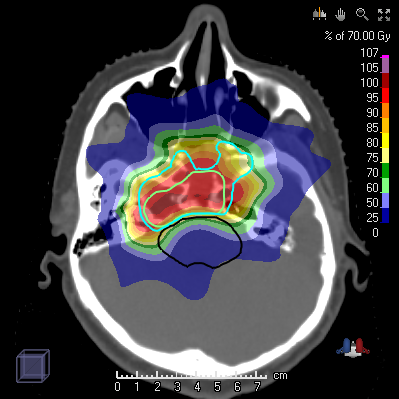Research profile
Proton therapy is a special radiotherapy procedure in which a tumor is irradiated with high-energy particles such as protons as opposed to photons used in conventional radiotherapy. From an accelerator, the protons are precisely directed at the tumor tissue as a focused beam at up to 60 percent of the speed of light. When the beam enters the human body, it is slowed down in such a way that the particles release most of their energy directly in the tumor, thereby damaging the tumor cells. The advantage of proton therapy is that a very high radiation dose can be deposited in the tumor while sparing surrounding healthy tissue. Special physical procedures allow to irradiate the tumor along its individual shape very precisely (see Fig. 1).
How to influence the biological effect?
Another difference to conventional photon radiotherapy is that proton beams are biologically more effective in killing tumor cells at the same dose - but this also applies to healthy cells. In order to achieve the best possible therapeutic success, it is important to understand the variable biological effectiveness of proton beams and to be able to predict it for individual patient irradiation. In order to develop the necessary prediction models, targeted radiobiological studies, evaluations of the radiation effect in patients in the course of clinical studies and precise simulations of the radiation are required.
Translation - from bench to bedside
The Medical Physics and Radiotherapy Group focuses its research on the clinical advancement of proton therapy. For this purpose, precise simulations of radiation physics, applied atomic and nuclear physics, radiobiology and statistical methods are used. Close cooperation with the three leading German proton therapy centers in Essen (WPE), Dresden (OncoRay) und Heidelberg (HIT), as well as with the graduate college Precision Proton Therapy , allows the results from research to be transferred to the clinic as quickly as possible.




![[Translate to English:] Studierende, Gespräch, Fenster Students are talking in front of a large window](/storages/zentraler_bilderpool/_processed_/7/3/csm_Fensterfront-Gesprache-2_5a466cb440.jpg)


